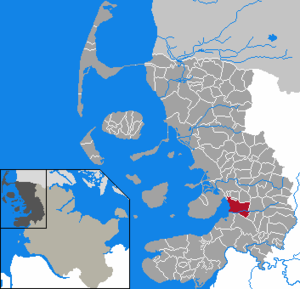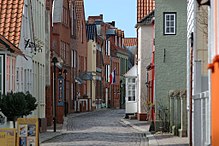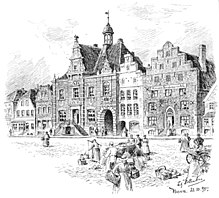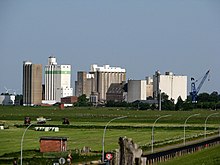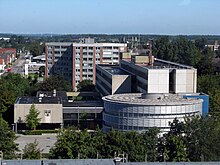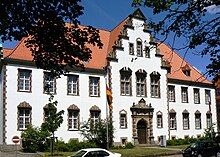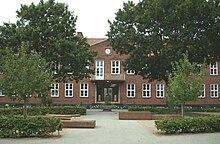Husum
| coat of arms | Germany map | |
|---|---|---|

|
Coordinates: 54 ° 29 ' N , 9 ° 3' E |
|
| Basic data | ||
| State : | Schleswig-Holstein | |
| Circle : | North Friesland | |
| Height : | 14 m above sea level NHN | |
| Area : | 25.81 km 2 | |
| Residents: | 23,189 (Dec. 31, 2019) | |
| Population density : | 898 inhabitants per km 2 | |
| Postal code : | 25813 | |
| Area code : | 04841 | |
| License plate : | NF | |
| Community key : | 01 0 54 056 | |
| LOCODE : | DE HUS | |
City administration address : |
Zingel 10 25813 Husum |
|
| Website : | ||
| Mayor : | Uwe Schmitz (independent) | |
| Location of the city of Husum in the district of North Friesland | ||
Husum ( North Frisian Hüsem ) is the district town of the district of North Frisia in Schleswig-Holstein . The city is known literarily as the gray city by the sea .
geography
Geographical location
The urban area of Husum extends on both sides of the Husumer Mühlenau . This crosses the two harbor basins within the urban area and flows into the Wadden Sea depth of the Hever . The city is also located at the transition from the Schleswig Geest to the Eiderstedter Marsch region, which begins to the southwest . In the adjoining outer area to the north, the Porrenkoog (originally: Nordhusumer Koog) and in 1848 the Dockkoog were diked to secure the Husum urban area. The Husumer Mühlenau flows past both bows to the south in the North Frisian Wadden Sea area. The northwestern district of Schobüll is in turn on the Geestrücken, which is advancing here to the northwest.
Neighboring communities
| Wobbenbüll | Hattstedt | Horstedt |

|
Schwesing | |
| Simonsberg | South march | Mildstedt |
City structure
The 1987 census in Germany registered the population on the basis of the following list of places to live. After that, the city was divided as follows:
- Dockkoog
- Dreimühlen (Danish: Tremølle )
- Husum (core city)
- Kielsburg (Danish: Kilsborg )
- Rödemis (Danish: Rødemis , North Frisian: Rööms ; village in the south of the city incorporated in 1934) with Norderschlag (new residential area) and fishing settlement
- Schauendahl ( Skovdal )
The municipality of Schobüll, which was only incorporated on January 1, 2007, was structured as follows in the 1987 housing directory:
- Altendorf
- Halebüll (Danish: Halebøl , North Frisian: Hälbel )
- Hockensbüll (Danish: Hokkensbøl , North Frisian: Hukensbel )
- Hockensbüllfeld
- Kronenburg
- Lund
- Porrenkoog (North Frisian: Porekuuch )
- Schobüll (Danish: Skobøl , North Frisian: Schööbel )
Further subdivisions of the core city Husum are also common:
- Old town
- Business park east
- Downtown
- Neustadt (Danish: Nystaden )
- Nordhusum (Danish: Nørre Husum ) (historic village incorporated in 1929)
- Osterhusum (Danish: Øster Husum ) (historic village incorporated in 1934)
history
Beginning of settlement
On the area of today's city there were settlement areas from prehistory and early history . In various archaeological work - e.g. For example, when the Osthusum mill pond was drained in 1866 and 1867, the railway bridge over the harbor was built in 1885 and the new lock for shipping in 1902 - corresponding finds from the Stone Age came to light. The first dated mention in the city chronicles, however, comes from the year 1252. The Danish King Abel tried to enforce a new tax in North Friesland, which the Frisians refused to pay. Abel then went to the field, but died in the battle on Mildedamm near Husembro (Husumbrücke).
In the past, the neighboring town of Mildstedt was the center of this area, but after the Second Marcellus Flood, the significance of the place changed: The storm surge known as the “Grote Mandränke” destroyed large parts of the coast. The country was torn apart, islands and the town of Rungholt sank, entire stretches of land were permanently flooded. As a result, Husum was henceforth a port city. The Husum people, who now had direct access to the sea, set up a marketplace. Goods could be delivered directly from distant places by ship, and a flourishing market soon developed.
urbanization
It should be the beginning of the rise of today's North Frisian district town. Husum had already increased in population in 1372 and had grown so much by 1398 that two villages emerged from it, which until 1431 bore the names Osterhusum and Westerhusum.
The beginning of the 15th century was marked by the increasing importance of the urban port. This resulted from a dispute between Denmark and the Hanseatic League . When the Hanseatic League of warships blocked the sound several times for all merchant ships that did not come from Hanseatic cities, the Danish king decreed that goods should be landed in Husum and transported from there by land to Flensburg .
In 1409 the place name Husum was mentioned for the first time. It is derived from the prefix Hus , which means something like houses or settlement, and the suffix um from the Nordic “an der Au”.
In 1421 Husum was given justice as a patch . By the contract of the day of St. Luke in 1448 the parish of Mildstedt was broken away . With the consecration of the first church in 1507, the detachment was completed. At that time Husum grew to a population of around 3,000 and developed into an important port and market place in North Frisia .
In Husum there was a leprosarium from around 1440 , which was known as the St. Jürgen Hospital and was originally in the northeast of the city, from 1571 in the end of Easter. The successor to the leprosarium was the “Gasthaus zum Ritter St. Jürgen”, which is now an old people's home.
Early modern age
In 1465, Husum received from the Danish King Christian I the privilege of employing a town bailiff, holding his own court, and permission to fortify the place with a wooden palisade . As early as 1472, Husum wanted to obtain city rights and took part in the unsuccessful uprising against King Christian I, which was initiated by his brother, Count Gerhard VII , Count of Oldenburg. King Christian took the place in 1472. Through the intercession of the bailiff von Ahlefeld and the stable man Tede Feddersen, the destruction of the patch was averted, but severe pillage, the deprivation of all privileges, the execution of around 70 citizens including the leaders and the eviction of other citizens practically destroyed the place in his Blossom. A severe penalty tax was imposed, which was not abolished until 1878.
From 1512 to 1521 the Walsrode carver Hans Brüggemann had his workshop in Husum and made the Bordesholm altar and the angel of the lost tabernacle for the old Husum Marienkirche from here. Expelled by the Reformation , which was spreading further and further in the north , Brüggemann went back to his hometown Walsrode in 1523.
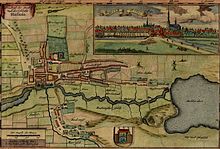
In 1522, when the Husum thaler was the first thaler in Schleswig-Holstein, the Reformation came to the city with the evangelical sermons of the preacher Hermann Tast, who has been employed at the Marienkirche since 1514 . She officially adopted the Lutheran faith in 1527. As one of the oldest Latin schools , the Husum School of Academics, today's Hermann Tast School , was founded in the same year .
The Duke Adolf von Schleswig-Holstein-Gottorf , who ruled from 1544 in the Gottorf part of the Duchy of Schleswig , had the castle in front of Husum built as a residence on the west coast on the site of an abandoned monastery from 1577 .
On April 20, 1603, Duke Johann Adolf granted the place town charter.
The founding of the neighboring town of Friedrichstadt in 1621 had a negative impact on Husum's economic development. In 1634 the Burchardi flood destroyed the island of Alt-Nordstrand, which had become rich through agriculture . Husum itself was not hit very badly, but many farmers from the area who regularly came to the market lost their lives, and many survivors lost their entire property. The economic boom was over for the time being.
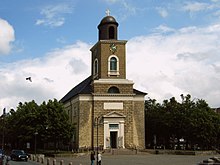
In the entire Danish state
In 1807 the old Gothic St. Mary's Church on the market , built in the early 15th century, was demolished due to its dilapidation. After many extensions, the old church gradually assumed the size of a cathedral church with a tower almost a hundred meters high. In the 20th century, the demolition was still regarded as one of the greatest losses in the architectural history of Schleswig-Holstein . In 1833 the new St. Mary's Church , built in the classical style based on plans by Christian Frederik Hansen , was inaugurated.
During the revolution of 1848 , as in large parts of Germany, there was a comparable campaign in Husum, the butter war : the Höker H. Petersen in the Krämerstrasse had bought all the butter available on the market to send it to Heligoland . This made it scarce and expensive. The dike workers at the new Dockkoogdeich got angry and attacked the business, damaging neighboring houses. Only a hastily assembled vigilante group was able to put an end to the hustle and bustle of the more or less drunk workers and arrest the men. A criminal court was held against them in the town hall.
In 1854 Husum received a railway connection with the Flensburg – Husum – Tönning line.
Time of the Prussian province Schleswig-Holstein
In 1867 Husum was, along with the duchies of Schleswig and Holstein part of the Prussian province of Schleswig-Holstein . The city began to grow again. This was particularly evident in the connection to the Marschbahn in 1887 , through whose economic influence one of the largest cattle markets in Northern Europe was created. In addition to the railway depot, the north station received a large cattle loading facility, where live cattle were loaded to the slaughterhouses in the south of Schleswig-Holstein and as far as Hamburg. In 1929 Nordhusum and in 1934 Osterhusum and Rödemis were incorporated, all of them villages in the parish of Mildstedt .
An early innovation push in the field of renewable energies , which was not yet so-called at the time , was the construction of a tidal power plant known as a flood power plant by the Hamburg engineer Emil Pein in 1912. A test facility for electricity production was built in the disused fish farm in Porrenkoog.

In the period between 1935 and 1945, Husum was the location of the Wehrmacht . The city had its own military registration office and an air base . In addition to the above-mentioned Schauendahl air base, the Schwesing airfield , which was still unfinished at the time , existed in the area of the neighboring community of Schwesing and was to function as a dummy airfield until the end of the war . Hunting units were mainly stationed at Schauendahl Air Base. In addition, the Navy has maintained a barracks in the city since 1940 , today's Air Base Barracks , which had functioned as a branch of the Mürwik Naval War School in Flensburg since the end of July 1943 . This Husum war school (Naval War School Husum) trained offspring officers for the naval artillery , fortress pioneers and the naval intelligence service until the end of the war .
Between September and December 1944, the Husum-Schwesing concentration camp existed about five kilometers northeast of Husum (in the Schwesingen district of Engelsburg ) ; the prisoners were used in the construction of the Friesenwall .
At the end of the Second World War , Germany was gradually occupied. On May 4, 1945, Hans-Georg von Friedeburg signed the surrender of all German troops in northwest Germany, the Netherlands and Denmark on behalf of the last Reich President Karl Dönitz , who had previously resigned in Flensburg-Mürwik with the last Reich government . The ceasefire entered into force at eight o'clock on May 5th. On the same day, a British advance command consisting of two soldiers arrived in Husum with a radio car. The two soldiers then negotiated with the sea commander for North Friesland, Captain Frank Aschmann, the mayor and the district administrator regarding the handover formalities. The following day, the navy barracks on Flensburger Chaussee, today's air base barracks, were handed over to the British to station their soldiers.
In the post-war period
A striking event for the city and its importance in the area of animal trade was the closure of the cattle market in 1970. By then, the market had become one of the most important transhipment points for live cattle in Germany. This importance was the result of the animals' pasture fattening in the North Friesland marshland. The administrative building of the then newly formed district of North Friesland was built on the vacated areas on the northern outskirts . A remnant of the tradition as a market location was the market hall in the southern area of the area, which existed until a few years ago.
Incorporations
The urban population growth was in part the result of multiple incorporations. These included Nordhusum on March 21, 1929 and the current districts of Rödemis and Osterhusum on April 1, 1938. On January 1, 2007, the previously independent community of Schobüll joined the neighboring village.
Population development
|
|
|
|
politics
City council
| Party / list | Seats |
| CDU | 8th |
| SPD | 7th |
| Green | 5 |
| Husum community of voters | 4th |
| SSW | 2 |
| FDP | 1 |
| total | 27 |
Martin Kindl (CDU) was elected mayor for the 2018–2023 election period. CDU and FDP form a parliamentary group.
mayor
In May 2017, Uwe Schmitz was re-elected (non-party).
coat of arms
Blazon : “In gold, a red picket fence with an open gatehouse, the red roof of which is decorated with three red flags on blue poles; in the gate opening two striding, red-tongued blue lions on top of each other. "
The image, first used as a seal and later as a coat of arms, comes from the late Middle Ages. The picket fence probably indicates the fortification right granted in 1465. In the center of the coat of arms are the Schleswig lions (opening the gate) .
Administrative community
Husum has been managing the Pellworm office since 2008 as part of an administrative consortium .
Town twinning
Husum's twin cities are:
- Kidderminster in Worcestershire , UK, since 1976
- Heilbad Heiligenstadt in Thuringia
- Gentofte , Denmark
- Trzcianka (German: Schönlanke , Poland )
In honor of the respective town twinning, streets were named after Kidderminster, Heiligenstadt and Schönlanke streets (Kidderminster-Ring, Heiligenstädter and Schönlanker Straße). In addition, the road bridge over the Au at the ZOB was named Kidderminsterbrücke .
Culture and sights
Museums


The core of the museum landscape in Husum is formed by the museums jointly managed in the Museum Association of North Friesland : the North Friesian Museum. Nissenhaus Husum in the Ludwig-Nissen-Haus , the open-air museum Ostenfelder Bauernhaus and the museum in the castle in front of Husum . The offer is supplemented by the Theodor-Storm-Haus in the Wasserzeile and the North Friesland Maritime Museum . Smaller exhibitions can be found in the Pole Poppenspäler Museum and in the Husum Christmas House .
The North Sea Museum Husum documents finds from the mudflats, provides information on coastal protection , everyday life on the Halligen and the lifestyle of the North Frisians. Furthermore, the visitor will find a documentation about the submerged settlement of Rungholt .
The Theodor Storm House presents the poet's rooms and his works, some of which have been preserved in their original form. It was Theodor Storm's house between 1866 and 1880, where he wrote several short stories.
The North Friesland Maritime Museum shows ships and models from the Middle Ages to the present day and provides insights into life with and on the sea. The main attraction is the wreck of a 17th century Frisian cargo sailing ship. This was uncovered in 1994 in the mudflats in front of the municipality of Uelvesbüll , then preserved for two years in a sugar solution and then brought to the exhibition. The buoy laying ship Hildegard from 1907 lies on a historic slipway at the inland port .
In Poppenspäler Museum is puppet theater theme. It is located in the castle in front of Husum and is run by the Pole-Poppenspäler-Förderkreis e. V., which also organizes the International Puppet Theater Festival Pole-Poppenspäler-Tage Husum , which takes place every September .
The Husum Christmas House features a Wilhelminian-style cultural monument, a Christmas museum (Alix Paulsen collection) and a historic shop from 1890.
Until 2013, the small museum showed pictures by the painter Helene Dauter, who was born in Gilge , East Prussia , and died in 1996 in Greater North Sea .
Buildings
Architectural sites in Husum include the Husum Castle with its gatehouse , the Market Square with the Marienkirche , the Tine Fountain and the Old Town Hall , the river port and the alley water series . This ensemble is complemented by the Husum water tower built in 1902 .
The castle in front of Husum was built by Duke Adolf von Schleswig-Holstein-Gottorf in 1577–1582. In the 17th century it was mainly used as the widow's seat of the ducal house. It was redesigned in 1750/51.
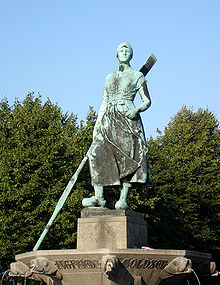
On the market square is the Asmussen-Woldsen monument designed by Adolf Brütt in the form of a fountain, which is named after two of the city's benefactors, August Friedrich Woldsen and his cousin Anna Catharina Asmussen . The monument is popularly known as the "Tine Fountain". It is adorned with a bronze sculpture depicting a young fisher woman with a headscarf, in wooden shoes and with an oar in her right hand. The "Tine fountain" is considered the landmark of the city of Husum.
The Marienkirche is located on the eastern edge of the market square . It was completed in its current form in 1833. The designs come from the architect and Danish state master builder Christian Frederik Hansen .
The inland port with the adjacent ship bridge is a former shipyard. It almost reaches the market place. Today it is mainly developed for tourism. The western end of the harbor is formed by the folding road and rail bridges that cross here. The restaurant ship Nordertor , built in 1936 and thus the oldest floating restaurant ship in Germany , has been in the inland port since 1978 . There are also several leisure boats, including the traditional sailing ship Brittantje , built in 1914, a steel flat-bottomed ship originally built in the Netherlands for the IJsselmeer fishery . The former buoy laying ship Hildegard has been lying on the former slipway of the shipyard that existed there until 1978 . The new town hall was built on the site of the shipyard itself in 1988/1989. In 2010, the state of Schleswig-Holstein leased the inland port from the Husumer Hafen e. V. (IGHH) to make it a port of call for traditional and museum ships.
The Theodor Storm House is located parallel to Hafenstrasse and in the extension of the ship bridge in the Wasserzeile , characterized by its proximity to the inland port and its small fishermen 's houses .
The Husum water tower was used for the central water supply for many years. Technically it was shut down in 1961, but still serves as a lookout tower.
Parks
The largest park in the city is the palace park around the palace in front of Husum. The Husum Palace Park was added to the register of the Schleswig-Holstein monuments register in 1994 as a garden monument. Every year in spring, the Husum crocus bloom - the bloom of around five million crocuses - is an attraction that is well known far beyond the city limits. The Duchess Garden has also been located on the palace island in front of the east and west facades of the palace since 2008.
Sports
The Husum Winter Marathon takes place every year in February or March . Founded in 1972, it is one of the oldest marathon events in Germany. During the port days in August, another athletics event takes place every year with the port day run.
The Schimmelreiter tournament is held every year in the Schobüll district for equestrian fans. It is organized by the local riding and vaulting club every year on the weekend after Ascension Day.
The most successful football club is composed of Frisia Husum and the Husum football club from 1918 merged Husum Sports Association . She played in the fourth-class league in the early 2000s . She currently plays in the fifth-class Oberliga Schleswig-Holstein (2019/20 season). The Husum bowlers were represented in the first Bundesliga for some time.
The TSV 1875 Husum , with about 1,900 members of the largest sports club in the city and offers mass and health sports performance-oriented groups. There is also the LAV Husum , which focuses on endurance sports and athletics.
The Golf Club Husumer Bucht e. V. has one of the most difficult courses in Germany with its 18-hole course.
Wheelchair sports ( wheelchair dance , wheelchair table tennis and wheelchair basketball ) are available at the RSC (Wheelchair Sports Club) Husum.
In addition to other sports clubs, Husum also has a diving club, the diving sports club Heuler Husum e. V.
Regular events
The most important annual folk festival is the Husum Harbor Days . As part of the city festival, which has been organized by the Husum advertising association since the early 1980s, various campaigns are offered. These include the so-called Hafentagelauf, the construction of a Ferris wheel ride on the market square and an artisan market in the castle courtyard. Other popular campaigns are the annual tug of war across the outer harbor, the so-called open ship according to the motto Mok almost in Husum! and since 2013 a cabaret festival.
Every year at Easter, many thousands of motorcyclists meet in Husum for the motorcycle church service to celebrate Easter together and start the new motorcycle season.
In October, visitors are invited to the Husum Crab Days. In addition, the crocus blossom festival (for the Husum crocus blossom in March / April) with the presentation of the newly elected crocus blossom queen is important. All of these events are organized by an event company. At the North Frisian farmers' market , which is usually held every two years, visitors are brought closer to agricultural production. The district farmers' association and the Husum advertising association cooperate as the organizer. The Honky Tonk pub festival takes place in Husum every year.
In addition, other regular events take place, such as Husum fish market, harbor flea market, Husum Matjestage, rarities of piano music , Husum culture night and Husum film days . The European Minority Film Festival takes place every two years in Husum. The Theodor Schäfer Vocational Training Center also hosts concerts from the Schleswig-Holstein music festival JazzBaltica every year . The Pole Poppenspäler Tage are a festival of artists from the field of puppet theater; they take place repeatedly in late summer.
Husumer Speicher cultural center
With the Husumer Speicher, a cultural center with regular and independently organized events is also represented in the city. Artists from Fettes Brot to John Abercrombie have performed here . The nationwide known punk band Turbostaat originally comes from Husum and had their first rehearsal room in Speicher.
Film set
Husum has been the chosen location for filming time and again since the 1930s. Well-known productions included the 1934 version of Der Schimmelreiter (directed by Hans Deppe and Curt Oertel ), the production Liberated Hands by Hans Schweikart from 1939 and the drama Nora by Harald Braun from 1944.
In the 1950s, Emil and the Detectives by Robert A. Stemmle and All Paths Leading Home were shot again by Hans Deppe and I will carry you on my hands by Veit Harlan . Productions since the turn of the millennium have been class reunions - a murder case among friends by Diethard Küster in 2001, Mord am Meer by Matti Geschonneck (2004) and Die Tote vom Deich also by Matti Geschonneck in 2005. The same year also Die Pferdeinsel by Jens Broecker . In 2009 Husum filmed 2 just in case - A song for the murderer .
In addition, he often made outdoor shots for various television series in Husum, for example for the ARD series Gegen den Wind and Die Strandclique in the 1990s as well as the hospital series Herzschlag - Das Ärzteteam Nord (1999 to 2003). In the 1980s, the television series Helga and the Northern Lights with Helga Feddersen , Gerda Gmelin and FJ Fürbringer was shot here. In 1985, a part of the television series The Riddle of the Sandbank was produced in the buildings of the former Husum shipyard in the inner harbor . From June 2011, the outdoor shots in Husum were filmed for the ARD pre-evening crime series Heiter bis tödlich: Nordisch herb with Loretta Stern and Frank Vockroth in the leading roles.
Economic structure
Trade and service industries
As a district town, Husum is the economic center of North Frisia. The city is the middle center for the west coast of Schleswig-Holstein with appropriate educational and administrative facilities. In the historic city center around the market square with the Marienkirche and the Großstraße there are numerous companies in the trade and service sector (including the sky branch of Coop , regional directorate of the Nord-Ostsee Sparkasse , Commerzbank branch, and fashion house CJ Schmidt ).
One of the largest weekly markets in Schleswig-Holstein is held on the market square every Thursday .
The Husum Shopping Center will be located at the former location of the Husum department store (formerly Hertie GmbH , previously Karstadt ) . The local Hertie branch was closed in 2009, as was the Quelle technology center. There were temporary usage options for both properties.
After initially the most Hertie location Husum department store had started its interim operations, this comprehensive in summer 2016. About planning of several plots of land area between Great Road, Castle corridor and road (Incl. City parking garage at Quick market) in favor of the construction of a downtown shopping center by the Prelios Property management has been closed again.
Outside of the inner city area , further companies from the trade and service sector have settled in the East industrial area since the 1980s. Today there are branches of various DIY stores ( Hagebaumarkt and OBI ), food retailers and other specialist stores. There are also a large number of small and medium-sized companies, among others from the mechanical engineering sector .
Land trade
At the outer harbor, two agribusiness companies ( ATR Landhandel and Hauptgenossenschaft Nord ) determine the commercial structure with their central warehouses. The high silo towers of the two companies shape the silhouette of Husum.
Renewable energy
As a further mainstay, the wind power industry is of particular importance for the city of Husum. The company Vestas has settled the central sales department for Central Europe in Husum. A research and development department is also located here. The company Senvion is on the site of the former Husum shipyard has a production site and the central service unit for the operation and monitoring of various wind farms represented.
This branch of industry is complemented by the HUSUM Wind trade fair, which takes place every two years . With almost 25,000 visitors (2008) it is known as the world's largest trade fair for the wind energy industry.
At the beginning of the 21st century it was planned to develop the port into a base for the construction and maintenance of offshore wind farms . The state government of Schleswig-Holstein withdrew its support for the project after a change of government in 2005 and redirected European funding. According to information from the Schleswig-Holstein newspaper publisher , even the use of the port as a service and maintenance location for offshore wind farms no longer seems to play a priority role for the state government.
The shipping company North Frisian Offshore GmbH is based in Husum and operates several large crew transfer vessels, including the Seewind 1 , to take workers to offshore wind farms.
tourism
Tourism is an important economic factor. At Dockkoog, Husum borders the Schleswig-Holstein Wadden Sea National Park . In 2009 the Wadden Sea was named a UNESCO World Heritage Site . A large part of the restaurants and souvenir shops are located around the inland port. The inland port is increasingly used by historical ships.
Infrastructure
traffic
Rail transport
The Husum train station is a hub of Schleswig-Holstein rail transport . The Husum – Kiel and Husum – Bad St. Peter-Ording lines meet the Marschbahn in or near the district town . In the station, the lines create a rail operation coordinated in the Schleswig-Holstein local transport network with an hourly frequency at 30 minutes. Local transport is currently operated on all of the routes mentioned by DB Regio . The hourly cycle from Husum in the morning towards Westerland and in the late afternoon in the opposite direction is compressed to a half-hourly cycle.
In long-distance transport , individual Deutsche Bahn AG intercity trains also stop in Husum. The Intercity trains are linked from Hamburg Dammtor directly to Westerland and are part of IC lines 26 , 27 and 30 .
The station is classified in station category 3 by DB Station & Service .
Bordered east historically as to the station area Bahnbetriebswerk Husum called EEC railway workshop . on. This is a subsidiary of the transport company Transdev GmbH . After the Nord-Ostsee-Bahn , also a subsidiary of Transdev, passed on the rail transport services on the Marschbahn to DB Regio as part of a tender, the car transport trains from the provider RDC Germany are primarily serviced here.
Bus transport
Local public transport within the city and to the neighboring communities of Hattstedt and Mildstedt has been characterized by the HusumBus brand of the transport company Autokraft since 2019 . It runs during the day on weekdays in every half hour (lines within the city) or hourly (flies to Mildstedt and Hattstedt). All have a common clock node at minute 10 (inner-city lines in addition to minute 40) at the Husum ZOB stop
At the Husum ZOB stop, there is also a link to regional bus services, which are currently (as of 2019) operated by the local bus companies Autokraft and Rohde Verkehrsbetriebe . The routes advertised by the district of Nordfriesland in the competition and also newly awarded for summer 2019 run in the direction of Bredstedt / Langenhorn (R120), Flensburg (SchnellBus R14), Nordstrand (R140), Ostenfeld (R145) and Erfde (R149) (at the destination change to Towards Rendsburg).
Shipping
Husum has a tidal port which is of great importance for the handling of agricultural goods. In terms of urban planning, the transshipment and storage facilities of the two agricultural trading companies located here dominate the silhouette of the city, which is visible from far into the surrounding area. The Husum harbor is also the location of a small fleet of shrimp cutters . The State Office for Coastal Protection, National Park and Marine Protection uses the port as a base for coastal protection . There is a marina at the inner end of the outer harbor. Further berths for pleasure craft can be found in the inland port. This has been administered by the Husumer Hafen interest group (IGHH) since summer 2010. The port is a member of the port cooperation Offshore-Häfen Nordsee SH . In 2011, goods handled amounted to 0.32 million t .
Road connections
Husum is at the intersection of various federal highways. The backbone is formed by federal highway 5 , which runs around the city in a north-south direction. In this area, the Husum bypass road built in the late 1980s , it has been developed as a two - lane motorized road with no height . It is crossed by the federal highways B 200 and B 201, which end in the city center . These establish the connection to the cities of Flensburg and Schleswig , as well as the A 7 . The B 5 continues south to Heide and joins the A 23 there . In a northerly direction it leads to the state border at Tønder ( Denmark ).
Bicycle traffic
In 2010 the city of Husum decided on a cycling strategy, according to which the infrastructure for cycling should be expanded and weak points in the cycle path network should be remedied.
Husum is connected to some tourist long-distance bicycle routes, including a. to the North Sea Coast Cycle Route (runs around the North Sea as EuroVelo route 12).
air traffic
The closest airfield is Husum-Schwesing airfield . It is located 3.8 kilometers northeast of the North Frisian district town and emerged from part of the Husum Air Base of the Bundeswehr .
media
The regional newspaper for Husum and the southern part of the district of North Friesland is the Husumer Nachrichten . It is published by the Schleswig-Holstein newspaper publisher based in Flensburg. In addition, the daily Flensborg Avis has its own local editorial office in Husum. In addition, the Nordfriesland range is distributed weekly in Husum . The advertising paper was created in Husum in 1973 and is now part of the Flensburg publishing house Kopp & Thomas . In addition, the Schleswig-Holstein newspaper publisher distributes its newspaper WochenSchau (issue for North Friesland) weekly in Husum.
Another media organ is the West Coast Open Channel . Local broadcasting is carried out by the Schleswig-Holstein Open Canal , an institution under public law . The radio station broadcasts, among other things, from a studio on the premises of the Hermann Tast School .
Husum is also the seat of the Husum publishing group . The Friesenanzeiger is also published by the MSM Werbeagentur & Verlag GmbH located here .
Public facilities
In Husum, the clinic of the same name is the largest location of the district's own clinic in North Friesland . The location is directly adjacent to the northeast corner of the palace park on Erichsenweg.
Since January 1st, 2008 Husum has been the seat of the State Office for Coastal Protection, National Park and Marine Protection (LKN). In the same building right next to the train station there is an office of the State Office for Agriculture, Environment and Rural Areas (LLUR) . Husum is the seat of the district administration of the district of North Friesland , there is a district court , as well as a foreign chamber of the labor court Flensburg . The BND (BND) operatively here to 2017 under the code name Federal Bureau of Telecommunications Statistics on the edge in the direction Schobüll a monitoring device for message traffic.
For a long time the city has been home to numerous military installations and units. Nowadays there are two barracks here : the air base barracks on Flensburger Chaussee (seat of the site elder ) and the Julius-Leber-Kaserne on Matthias-Claudius-Straße. The Bundeswehr service center on Industriestrasse is also a military property .
There are three libraries in Husum. The central library on the west coast of Husum is now located together with the North Frisian Museum. Nissenhaus Husum in the Ludwig-Nissen-Haus and also houses the city library. There is also the Dansk Bibliotek Husum , a branch of the Danish Central Library in Flensburg. It is located in the Danish cultural center Husumhus , which opened in 1975, on the Neustadt .
education
The school landscape in Husum occupies an important position for the district of North Friesland. In addition to two general high schools ( Hermann-Tast-Schule and Theodor-Storm-Schule ) there is a vocational high school in Husum , which is part of the vocational schools of the North Friesland district. The Allgemeine Hochschulreife can be acquired at all three schools . In addition, there are two community schools in Husum: the community school Husum-Nord and the Ferdinand-Tönnies-Schule . The general school offer is supplemented by four primary schools.
Support centers in Husum are:
- the Pestalozzi School (for people with learning disabilities)
- the Rungholt School (for the mentally handicapped)
Vocational students are taught in the vocational school of the North Friesland district in Husum .
Other German-speaking educational institutions are the Husum Adult Education Center and the Education Center for Tourism and Gastronomy (BTG). The latter is an institution of the Schleswig-Holstein Business Academy .
There is also the Husum Danske Skole , which is operated by the Danish School Association for Southern Schleswig . It is a Danish community school with ten grades .
The establishment of the Theodor Schäfer Vocational Training Center (TSBW) is of particular importance . It is a vocational training center for disabled trainees of the Diakonie-Hilfswerk Schleswig-Holstein .
In addition, Husum is the seat of the Nordfriesland district music school , which is located in the castle in front of Husum.
Associations and associations
Conservation associations
Husum is a central location for the Schleswig-Holstein Wadden Sea National Park . Both the Wadden Sea Protection Station's office since 2009 and the WWF's Wadden Sea project office are located in the National Park Center at the inland port . In addition, the BUND (district group North Friesland and local group Husum) has its offices in the Husum National Park House.
Music associations and choirs
In Husum there are music associations from music schools to brass bands. The largest music association is the Rödemis Spielmannszug & Jugendblasorchester . One of the most famous choirs in Husum is the concert choir Theodor Storms Chor. The choral society with the full name Theodor Storms Chor von 1843 e. V. is based in Husum. The Husum Gospel Singers e. V. Other choirs are u. a. The Husum Stadtkantorei - the oratorio choir and church choir at St. Marien -, the Husum Shanty Choir, the Mixed Choir Husum and the vocal ensemble Kleiner Chor Husum.
sports clubs
There is a wide range of sports clubs in Husum. The largest sports club is TSV Husum. You can read more about this in the #Sport section above.
Other clubs
The Theodor Storm Society is based in the Theodor Storm House in the Wasserzeile. The Nautical Association of North Friesland e. V. is based in Husum. The association aims u. a. the promotion of all matters of general interest in merchant shipping, fishing, ports and maritime affairs.
Religions
The vast majority of Husum residents are Evangelical Lutheran . There are also parishes of the Catholic Church , the Evangelical Lutheran Danish Church and free parishes. There is also the New Apostolic Church in Husum and the free Christian community “Word of Life North Sea Coast e. V. “( Federation of Free Church Pentecostal Congregations ).
Church building
- Marienkirche (ev.)
- Friedenskirche (ev.)
- Christ Church (ev.)
- Reconciliation Church (ev.)
- Little Church by the Sea , Schobüll (ev.)
- Husum danske kirke (ev., Danish)
- Church of the Resurrection (ev.-free)
- Free Christian Congregation (ev.-free)
- Albert Schweitzer House (ev., Rödemis)
- Christ the King and St. Knud (Cath.)
- New Apostolic Church
- Missionary organization "Word of Life" (free)
Personalities
Hermann Tast
(date unknown)Fanny Countess zu Reventlow (around 1900)
Adolf Brütt (1909)
Honorary citizen
- Karl Ernst Laage (1920–2017), former director of the Hermann Tast School, Theodor Storm expert and founder of modern Storm research, built up the Theodor Storm Museum and Archive
sons and daughters of the town
To 1900
- Hermann Tast (1490–1551), reformer
- Nicolaus Peträus (1569–1641), theologian, superintendent in Ratzeburg
- Hermann Latherus (1583–1640), lawyer
- Johannes Christoph Meurer (1598–1652), lawyer and diplomat of the Hanseatic City of Hamburg
- Johannes Mejer (1606–1674), cartographer
- Augustus Giese (1620–1696), lawyer
- Friedrich Giese (1625–1693), civil servant in the Danish service
- Peter Axen (1635–1707), lawyer, philologist, humanist and diplomat
- Laurentius Laurentii (also Lorenz Lorenzen) (1660–1722), Protestant pastor and hymn poet
- Peter Goldschmidt (1662–1713), Protestant preacher, defender of the belief in witches
- Johann Christian Gottlieb Schaumann (1768–1821), philosopher, educator and university lecturer
- Caspar Arnold Engel (1798–1863), politician, interim Landdrost and member of the Frankfurt National Assembly 1848/1849
- Peter Wilhelm Forchhammer (1801–1894), archaeologist, philologist, politician, member of the Prussian mansion
- Peter Diederich Johannsen (1801–1886), master carpenter and member of the Hamburg Parliament
- August Decker (1806–1884), German Evangelical Lutheran clergyman and author
- Georg Beseler (1809–1888), lawyer and politician, member of the Frankfurt National Assembly 1848/49
- Theodor Storm (1817–1888), writer, described his hometown in many works, see Die Stadt (poem)
- Paul Gottburgsen (1832–1903), Mayor of Aabenraa, member of the Reichstag
- Richard von Hagn (1850–1933), architectural and landscape painter of realism and naturalism
- Hans von Petersen (1850–1914), marine painter
- Adolf Brütt (1855–1939), sculptor, creator of the Theodor Storm monument (1898) and the Asmussen-Woldsen-Fountain, which has become a landmark in Husum (1902)
- Ludwig Nissen (1855–1924), diamond dealer who emigrated to New York City and founder of the Ludwig-Nissen-House named after him (today: Nordfriesisches Museum. Nissenhaus Husum )
- Emil Schiller (1865–1945), pastor and missionary in Japan
- Richard Petersen (1865–1946), technical manager for the construction of the Wuppertal suspension railway
- Margarete Böhme (1867–1939), writer
- Oskar Vogt (1870–1959), neuroanatomist, psychiatrist, dissected Lenin's brain in the 1920s
- Fanny zu Reventlow (1871-1918), German painter and writer
- Hermann Siemonsen (1882–1958), Lutheran clergyman
- Goslar Carstens (1894–1978), lawyer, local politician, local historian and author; Mayor of Husum in 1946
From 1901
- Margareta Erichsen (1916–2006), painter and illustrator
- Johann Max Böttcher (1920–2014), entrepreneur and philanthropist
- Elisabeth Dering (1921–1997), painter
- Uwe Röhl (1925–2005), organist and church musician
- Rolf Bohnsack (1937–2009), popular actor
- Claus-Frenz Claussen (* 1939), founder of neurootology in Germany
- Hans Hartz (1943–2002), musician and songwriter
- Ulf von Hielmcrone (* 1944), lawyer, author and politician (SPD)
- Eckhard Feddersen (* 1946), architect
- Ruth Springer (* 1946), politician (SPD)
- Rainer Trox (* 1946), soccer goalkeeper
- Herwig Ahrendsen (* 1948), handball player
- Günther Fischer (* 1950), architect and university professor
- Manfred Lange (* 1950), General in the Bundeswehr
- Wolfgang Noack (1951–2018), actor and radio play speaker
- Norbert Hansen (* 1952), union chairman and board member
- Hans-Ruprecht Leiß (* 1954), draftsman and painter
- Harm-Peer Zimmermann (* 1958), Professor of Popular Literatures and Media at the University of Zurich
- Ulrich Nehls (* 1959), church musician and academic music teacher
- Marina Braun (* 1960), actress, radio and television presenter
- Jochen Hein (* 1960), painter
- Iris Paech (* 1961), singer, producer and radio presenter
- Ingo Schulz (* 1962), church musician, organist and composer
- Johann Wadephul (* 1963), lawyer and CDU politician, Member of the Bundestag since 2009
- Hauke Braack (* 1963), indoor and beach volleyball player, volleyball player of the year 1988
- Lars Harms (* 1964), SSW politician
- Dörte Hansen (* 1964), writer
- Frank Jacobsen (1964–2014), actor and director
- Joachim Friedrich Quack (* 1966), Egyptologist and recipient of the Leibniz Prize
- Frank Bremser (* 1972), radio presenter, comedian and singer
- Isgaard (* 1972), singer
- Hajo Wulff (* 1972), handball player and coach
- Wiebke Puls (* 1973), actress and singer
- Jan Wayne (aka Jan Christiansen) (* 1974), DJ, singer and music producer
- Matthias Holst (* 1982), soccer player
- Torge Johannsen (* 1983), handball player
- Morten Jensen (* 1987), soccer goalkeeper
- Maike Timmermann (* 1989), soccer player
- Janina Uhse (* 1989), actress
- Michael Nicolaisen (* 1995), handball player
Connected to Husum
- Born in Tønder , Anne-Dora Arnold (1883–1971) grew up in Husum and later became an art and portrait painter; she was married to the Simplicissimus painter Karl Arnold .
- The baroque composer Nicolaus Bruhns (1665–1697), who was born in Schwabstedt , became known as a Husum organist.
- The writer Karl Heinrich Keck (1824–1895) was Rector of the Husum School of Academics from 1870 to 1887 and teacher of Ferdinand Tönnies. Eugen Petersen , Ludwig Matthiessen and Rudolf von Fischer-Benzon taught during his time as rector.
- Rudolf Eucken (1846–1926), writer and winner of the Nobel Prize for Literature, was briefly a high school teacher in Husum.
- Ferdinand Tönnies (1855–1936), the founder of sociology in Germany, graduated from the Hermann-Tast-Schule (school for scholars) in 1872. At that time the Tönnies family lived in the "Kavaliershaus" near the castle; his memorial has been nearby since 2005.
- The painter Elisabeth Wilhelmine Johanna Bitterling-Wolters (1892–1982) lived in Husum from 1962 until her death
- The theologian and bishop Alfred Petersen (1909-2004) was provost in Husum for ten years .
- Gundel Paulsen (1926–2018), teacher and editor of anthologies, lived in Husum from 1974 until her death
- Peter-Harry Carstensen (* 1947), politician (CDU), 2005–2012 Prime Minister of Schleswig-Holstein, graduated from the Hermann Tast School in 1966.
- The historian and former long-time director of the Nordfriisk Instituut Thomas Steensen (* 1951) lives in Husum.
- The extreme canoeist Freya Hoffmeister (* 1964) lives in Husum.
cenotaph
The memorial for the fallen from Husum from 1870/71 is located in the castle park .
Others
- An Airbus A321 operated by Lufthansa (D-AIRS) has been named Husum since 1996 .
- Husum is considered the German city with the highest annual average wind speed.
- The Red Holstein Husum or Danish protest pig was bred by popular tradition, because it was not allowed by the Danish living in and around Husum minority under Prussian rule, the Dannebrog to hoist. This is how this domestic pig emerged, which is similar in color to the Danish flag.
literature
- Society for Husum Town History: History of Husum. From the beginning to the present. Husum 2003, ISBN 978-3-89876-084-3 .
- Ulf von Hielmcrone : Husum. Guide through the Stormstadt. 3rd revised, ext. Edition. Husum 2001.
- Thomas Steensen: Little Husum ABC. Husum 2014, ISBN 978-3-89876-720-0 .
- UA Christiansen: The history of Husum in a simple representation. Husum 1903.
- Husumer Nachrichten (Ed.): 350 years of the city of Husum. Festschrift of the Heimatfest 4. – 12. July 1953. Guide to the events. Husum 1953.
Web links
- www.husum.de - Website of the city of Husum
- www.husumer-stadtgeschichte.de - Society for Husum Town History e. V.
- Illustration of the city 1588 in Civitates orbis terrarum by Georg Braun
Individual evidence
- ↑ North Statistics Office - Population of the municipalities in Schleswig-Holstein 4th quarter 2019 (XLSX file) (update based on the 2011 census) ( help on this ).
- ^ Housing directory Schleswig-Holstein 1987. (pdf) Retrieved on November 2, 2019 .
- ↑ Gerret Liebing Schlaber: Administrative tilhørsforhold mellem Ejderen og Kongeåen indtil 2007 , Flensburg 2007, p. 248
- ^ Housing directory Schleswig-Holstein 1987. (pdf) Retrieved on November 2, 2019 .
- ^ Nordfriisk Instituut: Nordfriesland Karte , Bräist / Bredstedt 2011
- ↑ see presentation of the Society for Leprosy under Documentation: Medieval Leprosoria in Schleswig-Holstein and Hamburg (PDF) and Medieval Leprosoria in Schleswig-Holstein and Hamburg - Annex, details of the leprosoria ( Memento of December 10, 2014 in the Internet Archive ) (PDF)
- ↑ Description of the old people's home at husumer-stadtgeschichte.de (PDF) accessed on December 8, 2014
- ^ History sh ( Memento of October 17, 2007 in the Internet Archive )
- ↑ Dietrich Ellger in Heinz Rudolf Rosemann (ed.): Lower Saxony, Hanseatic cities, Schleswig-Holstein, architectural monuments. Reclams Kunstführer, Germany, Volume 5, 4th edition, Stuttgart 1971, p. 332
- ^ Christiansen, 1913
- ↑ Information on geschichte-sh.de ( Memento from September 26, 2007 in the Internet Archive )
- ↑ 300 years of the garrison town of Husum. 50 years of the Bundeswehr location , page 13; Retrieved on: June 3, 2017
- ↑ 300 years of the garrison town of Husum. 50 years of the Bundeswehr location , page 12; Retrieved on: June 3, 2017
- ↑ 300 years of the garrison town of Husum. 50 years of the Bundeswehr location , page 13 and page 68; Retrieved on: June 3, 2017
- ↑ a b 300 years of the garrison town of Husum. 50 years of the Bundeswehr location , page 14; Retrieved on: June 3, 2017
- ↑ The surrender on the Timeloberg (PDF, 16 S .; 455 kB)
- ↑ Regional .
- ^ City of Husum: Official announcement of the municipal election results in the city of Husum
- ↑ frr: mayoral election in Husum: Uwe Schmitz re-elected as mayor Husum - shz.de .
- ↑ Schleswig-Holstein's municipal coat of arms
- ↑ Description of the partnerships at husum-tourismus.de. Retrieved December 2, 2018 .
- ↑ a b Maritime Museum: Home .
- ↑ Maritime Museum: Home .
- ^ Poppenspäler Museum in the castle in front of Husum , accessed on August 8, 2015
- ↑ Pole Poppenspäler Förderkreis , accessed on September 11, 2019
- ↑ History - MS NORDERTOR. In: ms-nordertor.de. Retrieved October 22, 2016 .
- ^ Restaurant ship Nordertor | Husum tourism . In: Husum Tourism . ( husum-tourismus.de [accessed on October 21, 2016]).
- ↑ Information on maritimheute.de ( Memento from March 4, 2014 in the Internet Archive )
- ↑ Husum Palace Park (PDF) accessed on August 8, 2015
- ↑ Husum Palace Gardens ( Memento of the original from April 8, 2015 in the Internet Archive ) Info: The archive link was inserted automatically and has not yet been checked. Please check the original and archive link according to the instructions and then remove this notice.
- ↑ RSC Husum ( Memento from October 16, 2012 in the Internet Archive ) (wheelchair sport)
- ↑ Diving , accessed on August 8, 2015
- ↑ Stefan Petersen: Husumer Hafentage: A colorful mix of the new and the tried and tested. In: Husumer Nachrichten . June 13, 2015, accessed June 16, 2015 .
- ↑ Rüdiger Otto von Brocken: Store Opening in Husum: new concept at Old Town - shz.de .
- ↑ Juliane kahlke: Husum department store: Pick of the Week: Opening in the former Hertie - shz.de .
- ↑ See list of DB Station & Service passenger stations
- ↑ transdev: EWG Eisenbahnwerkstatt-Gesellschaft mbH. (pdf) Retrieved October 15, 2018 .
- ↑ Balance sheet of the German seaports 2011 . In: Hansa , Heft 4/2012, pp. 77-81, Schiffahrts-Verlag Hansa, Hamburg 2012, ISSN 0017-7504
- ^ City of Husum: Bicycle traffic concept / City of Husum. Retrieved June 26, 2017 .
- ^ NDR: North Sea Coast Cycle Route in Schleswig-Holstein. Retrieved May 23, 2017 .
- ^ MoinMoin, The History of Kopp & Thomas Verlag GmbH ; Retrieved on: August 19, 2014
- ↑ shz the media house, weekly newspapers ; Retrieved August 19, 2014
- ^ Open Canal Schleswig-Holstein , accessed on April 15, 2018
- ^ Theodor Storms Chor, Husum , accessed on August 8, 2015
- ^ Gospel Choir Husum Gospel Singers , accessed on August 8, 2015
- ↑ Husumer Stadtkantorei ( Memento of the original dated August 2, 2015 in the Internet Archive ) Info: The archive link was inserted automatically and has not yet been checked. Please check the original and archive link according to the instructions and then remove this notice. , accessed August 8, 2015
- ^ Husum Shanty Choir , accessed on August 8, 2015
- ↑ Mixed Choir Husum e. V. , accessed on August 8, 2015
- ↑ Kleiner Chor Husum , accessed on August 8, 2015
- ^ Nautical Association of North Friesland , accessed on August 8, 2015
- ↑ The association .
- ↑ Charliebravo.de .

